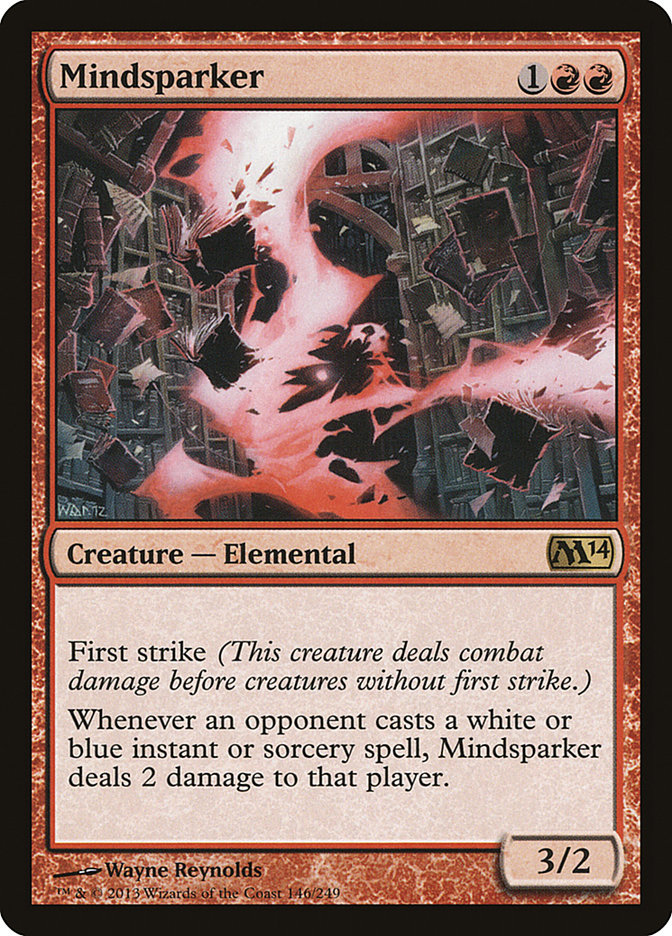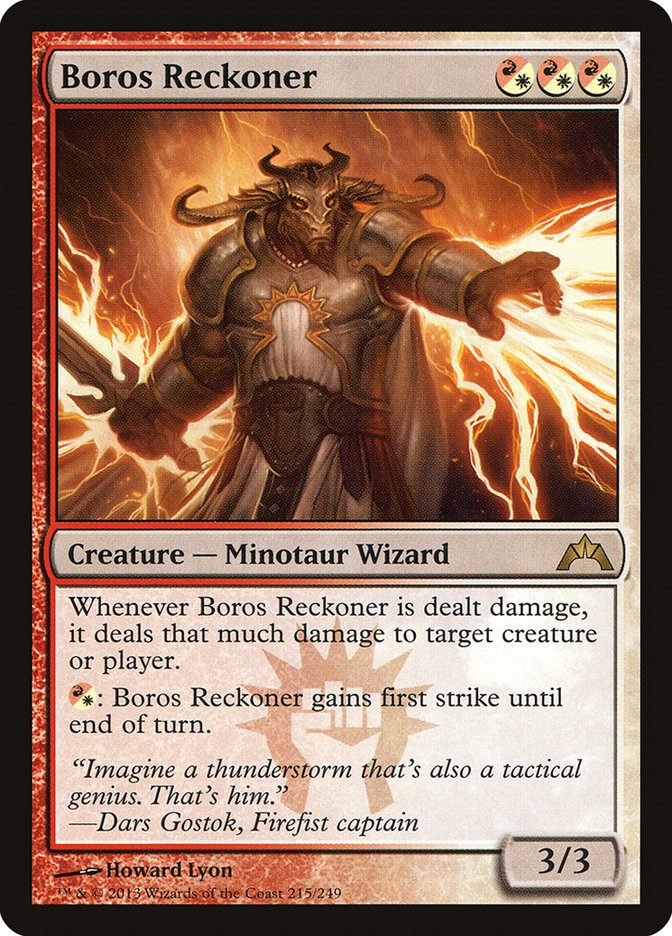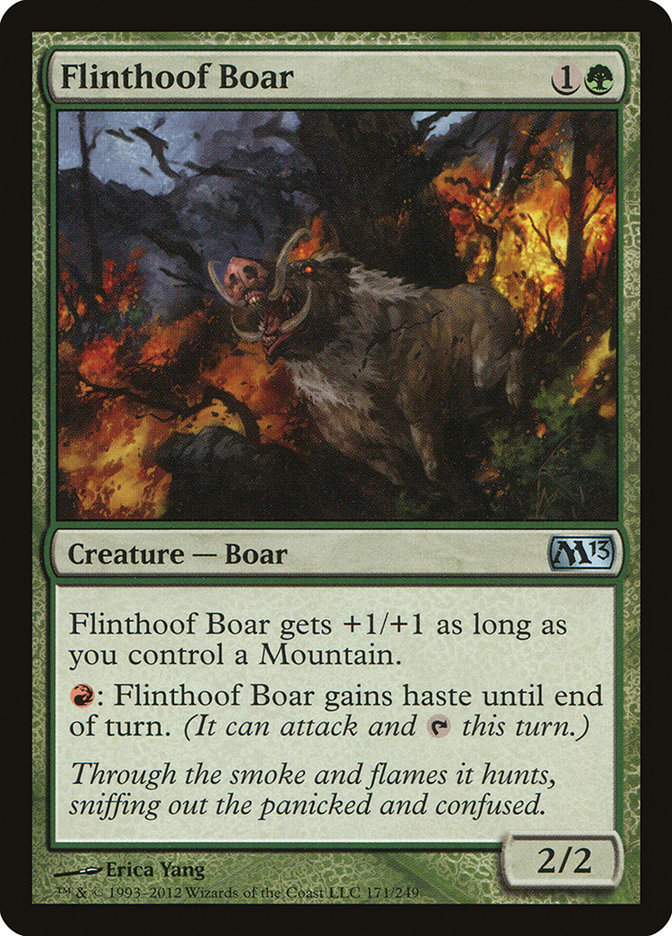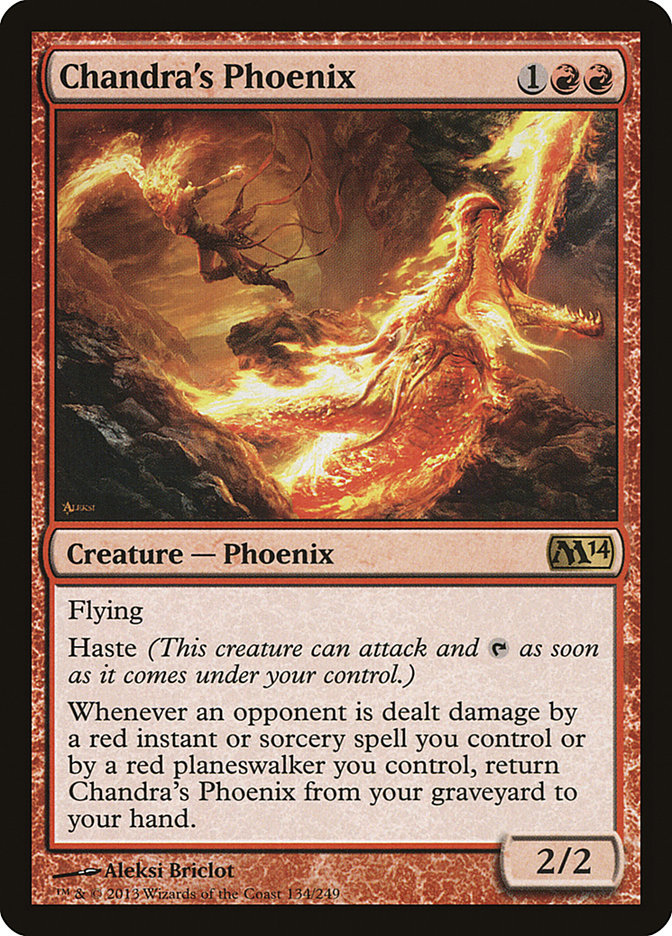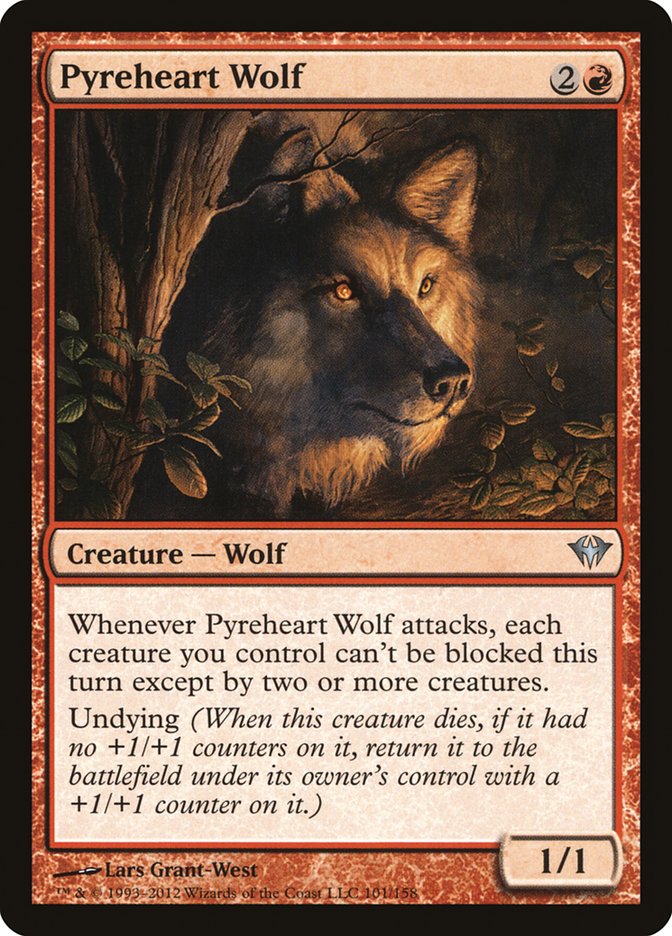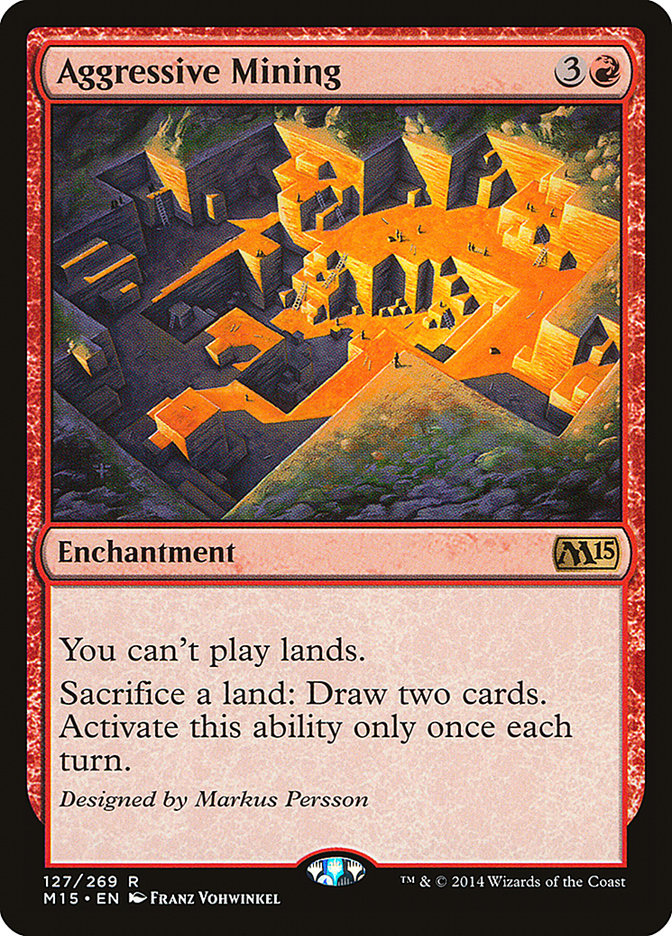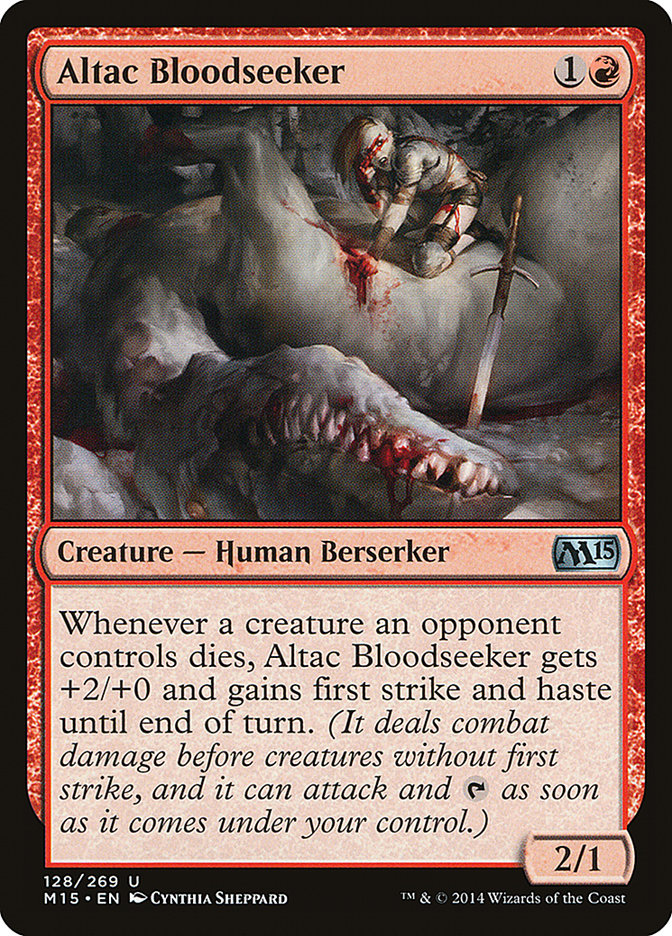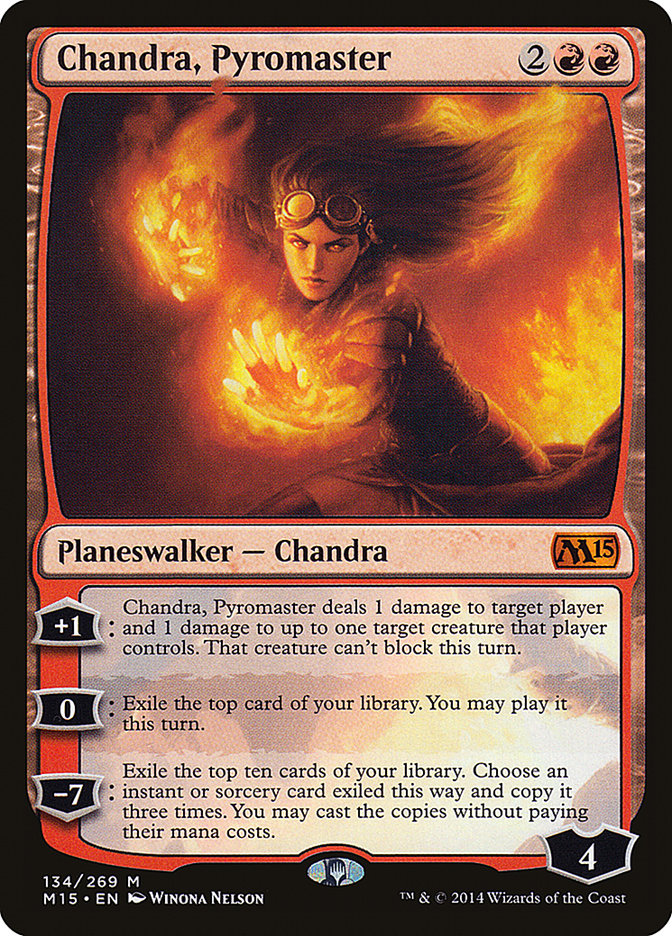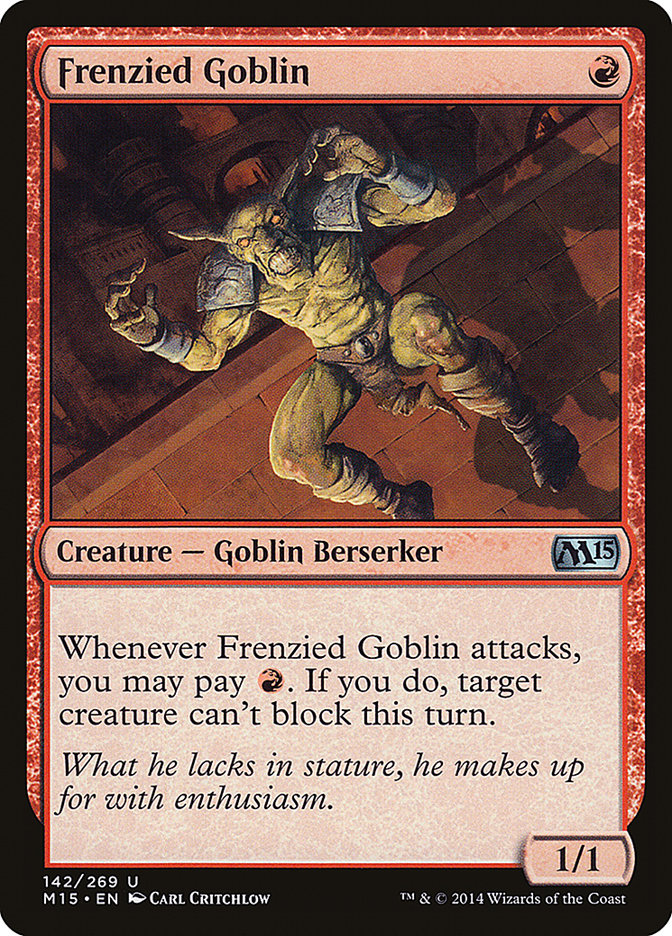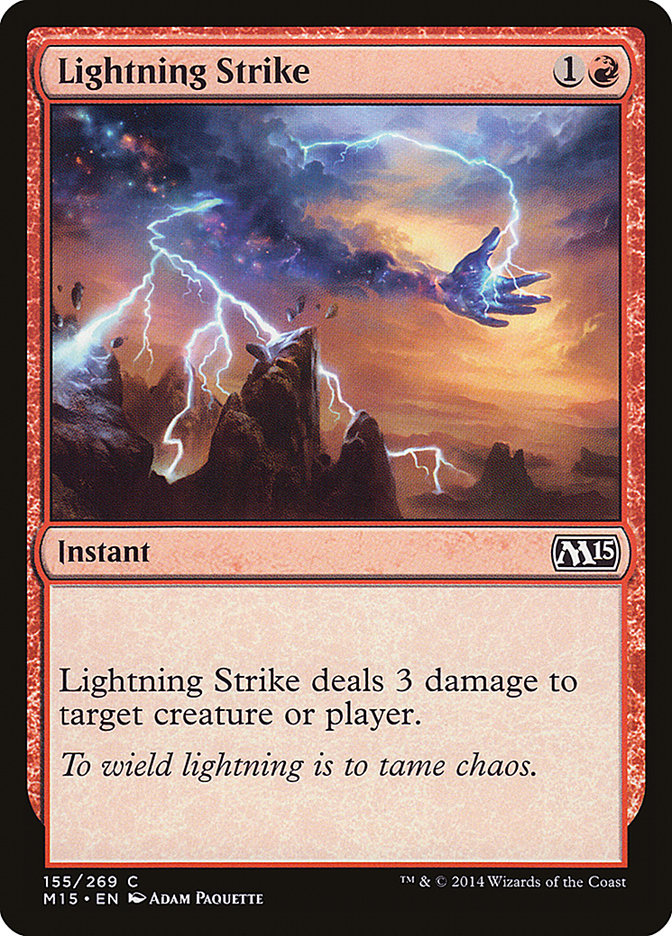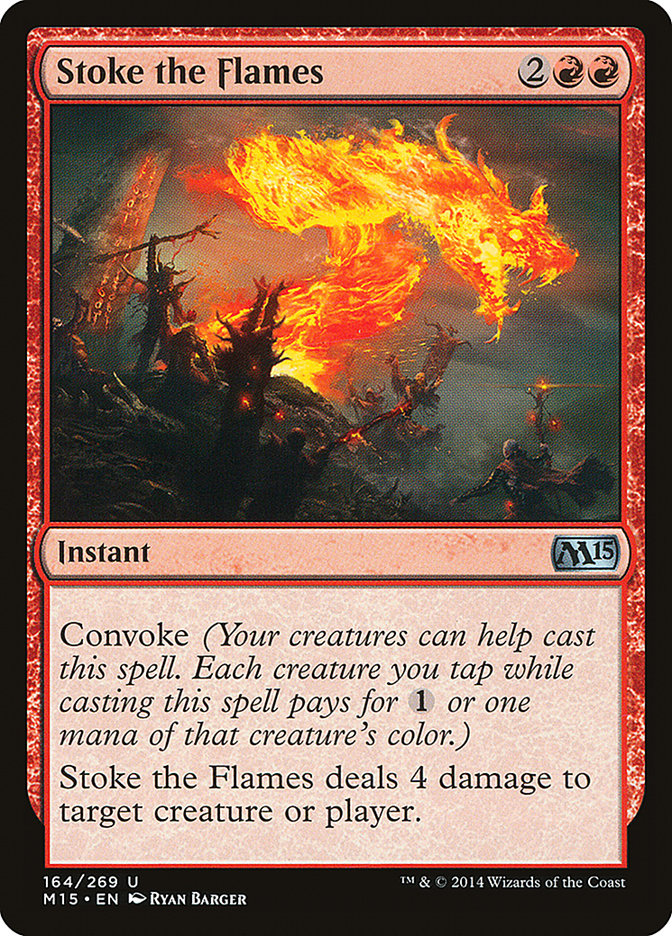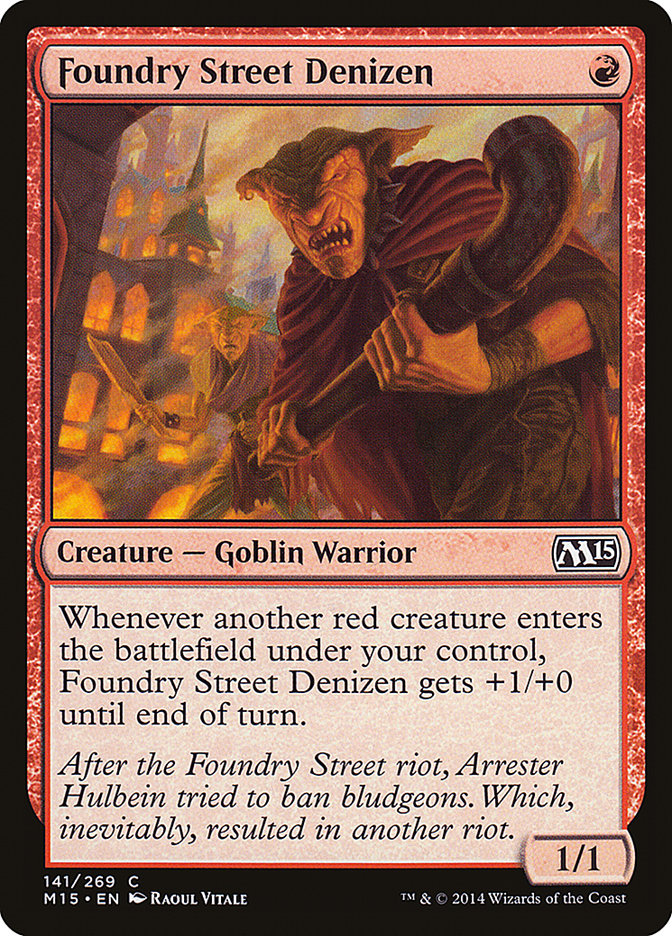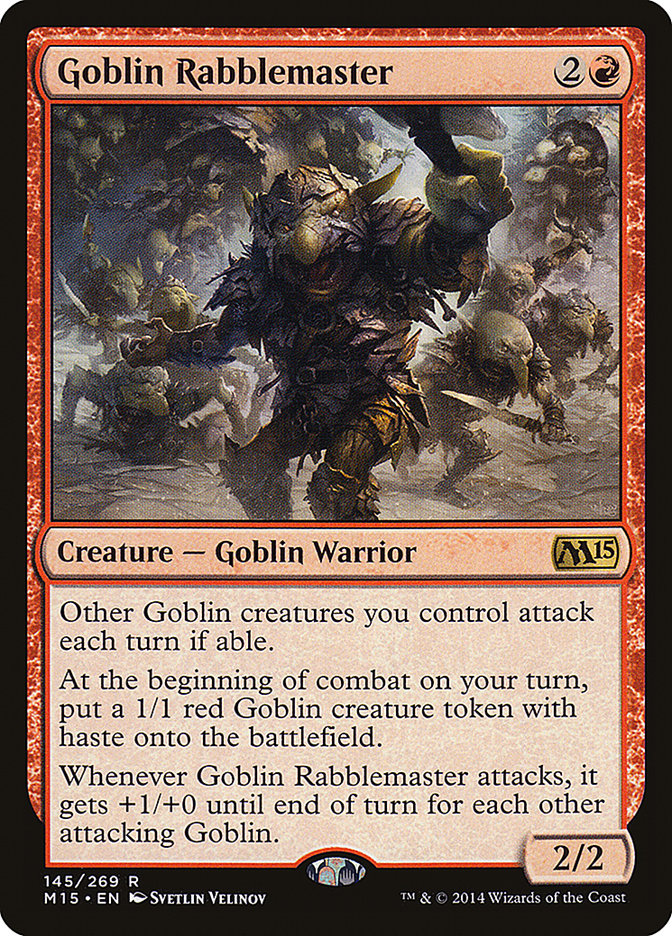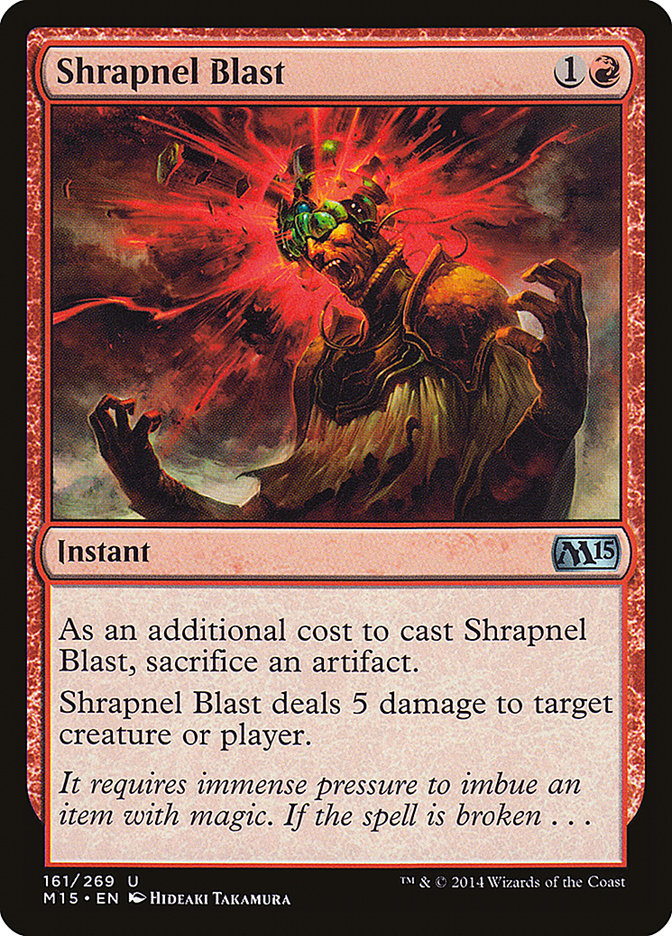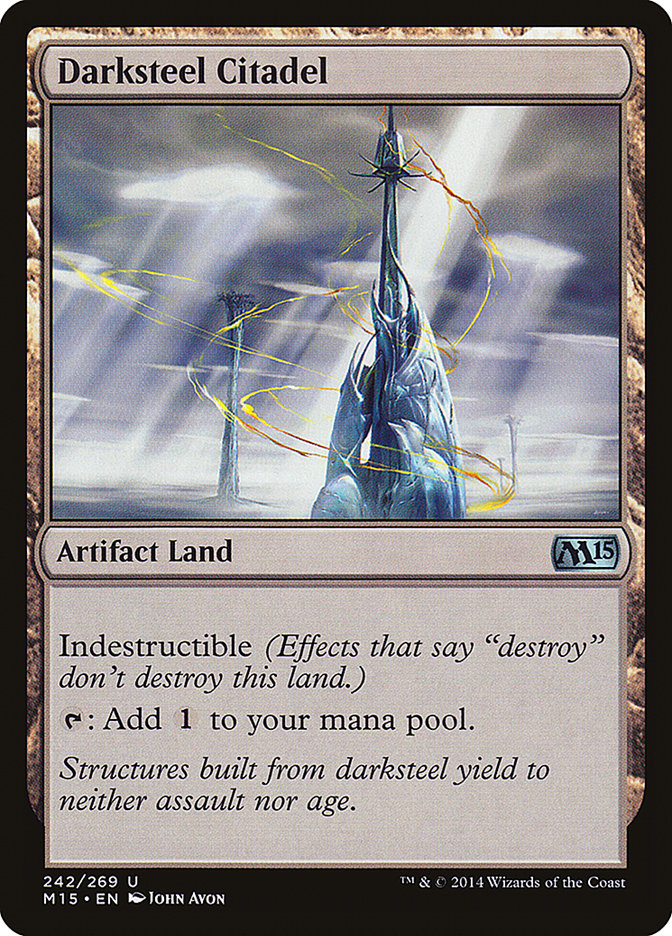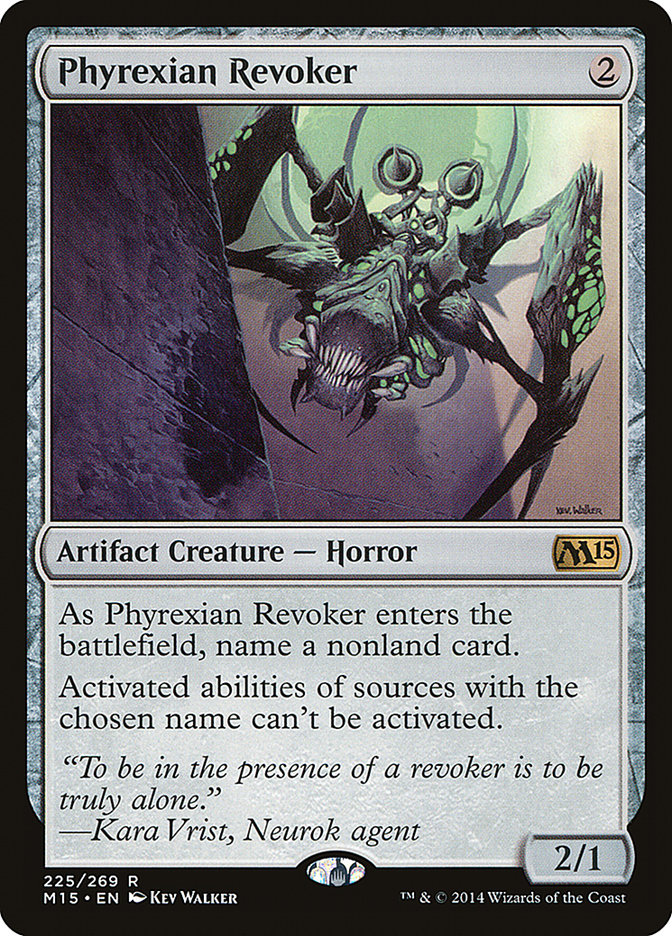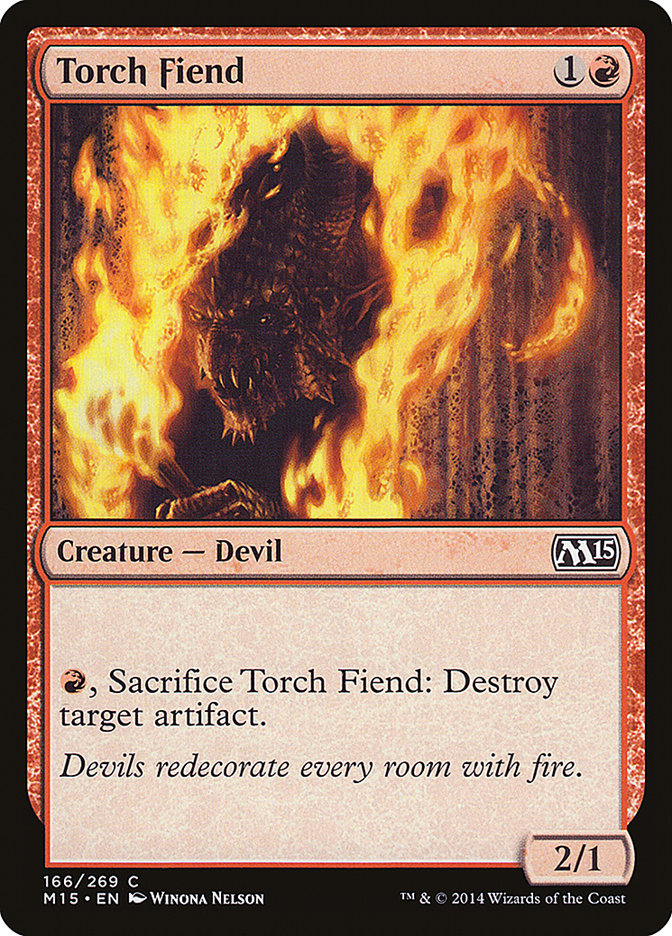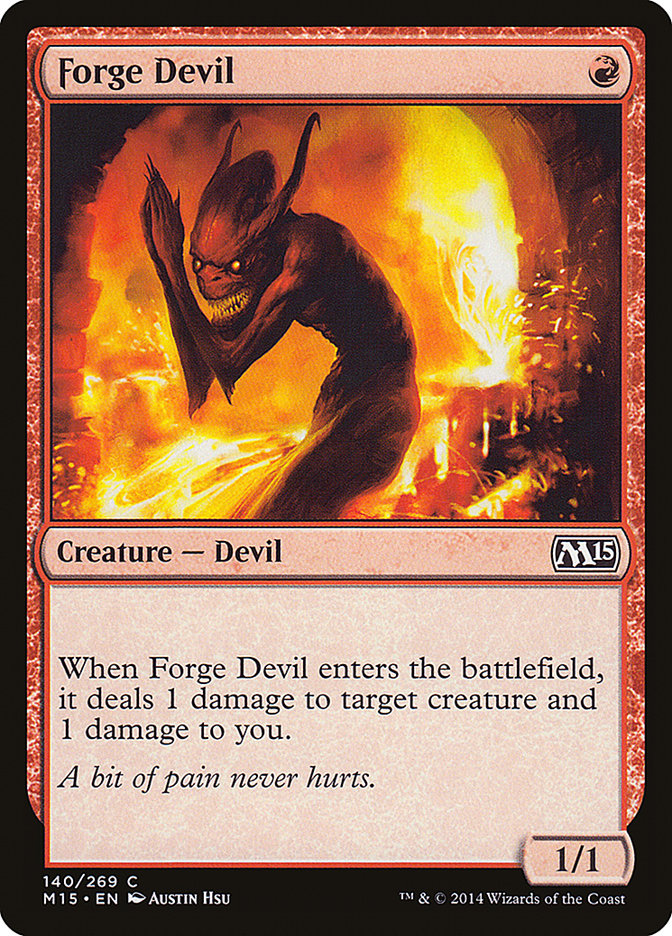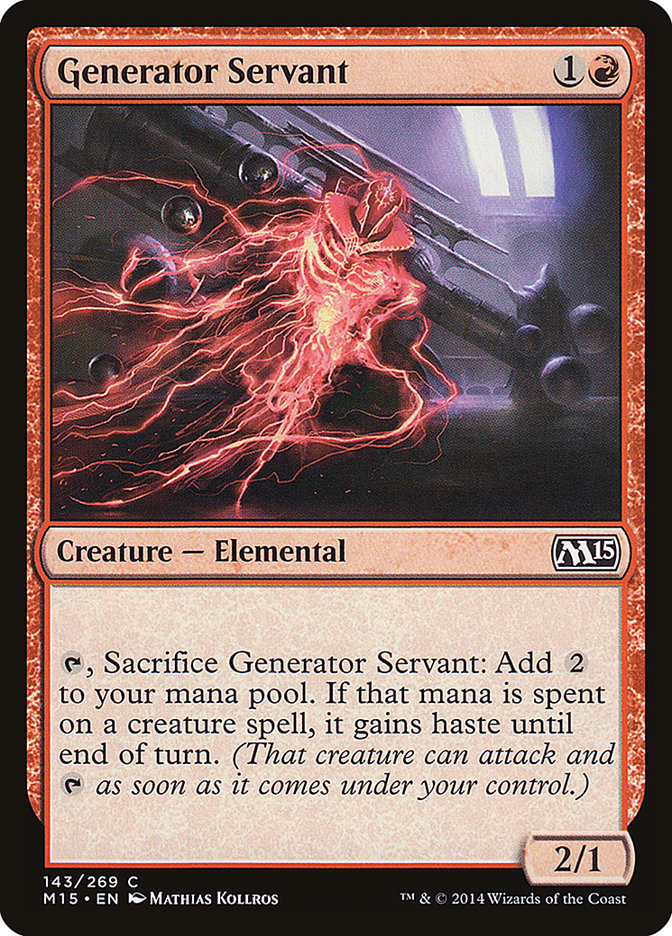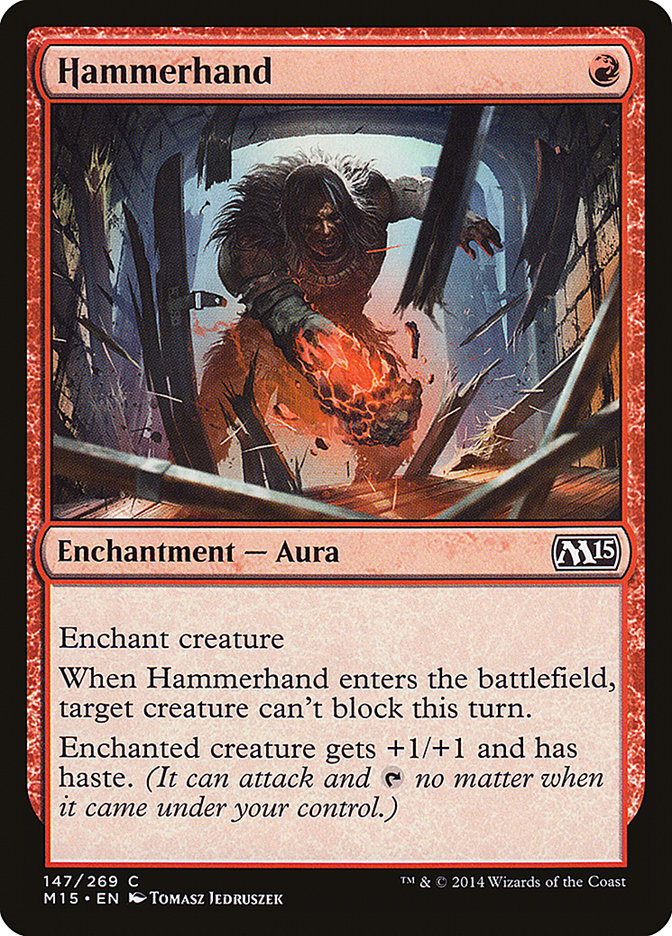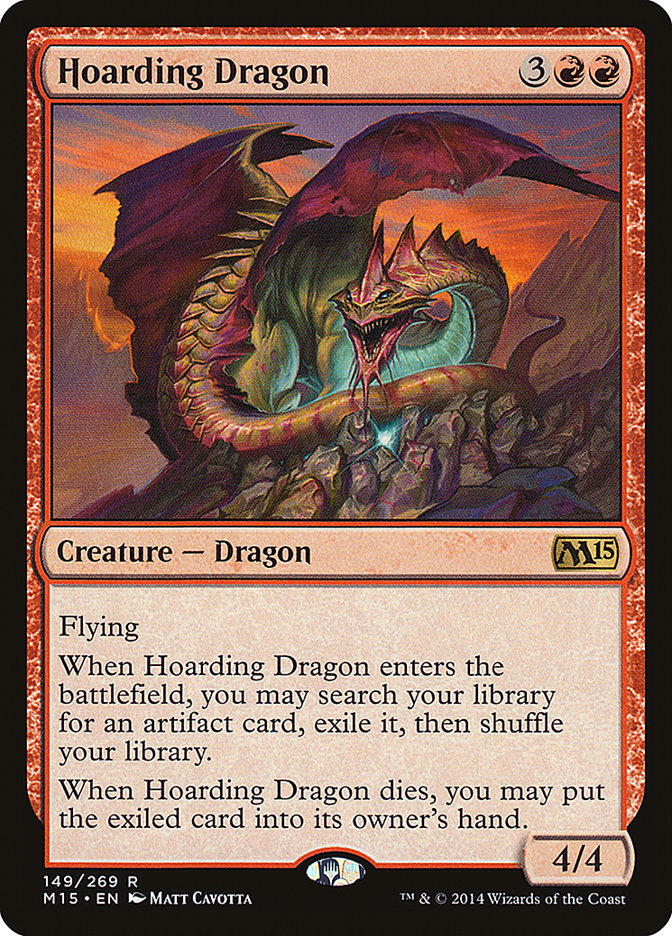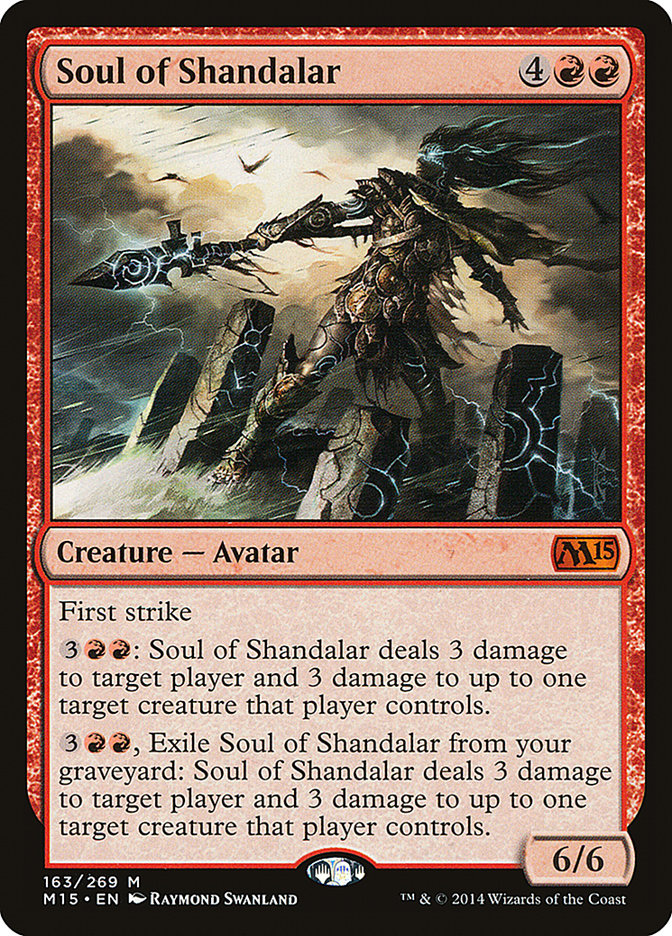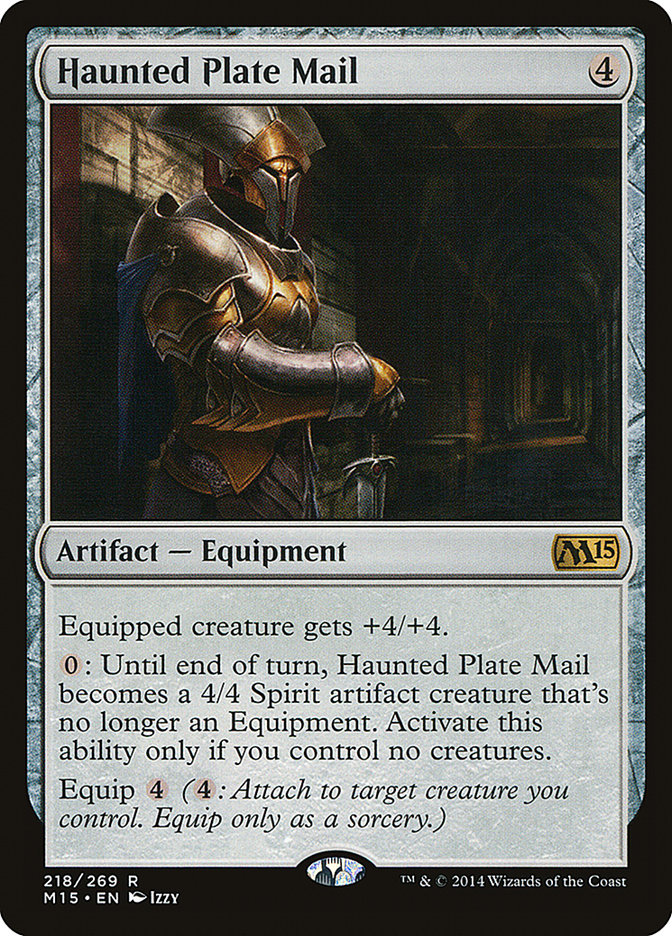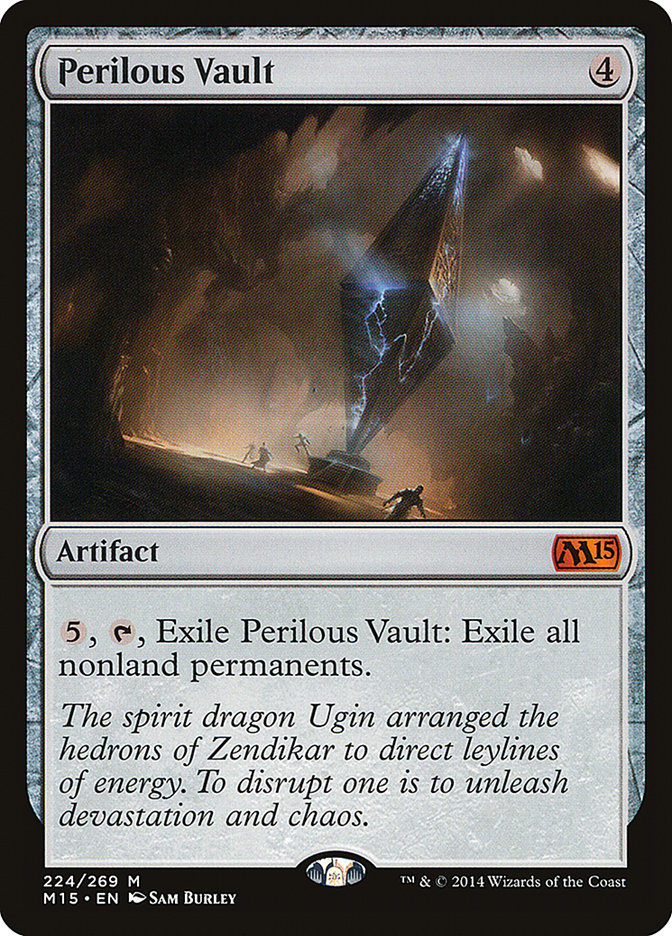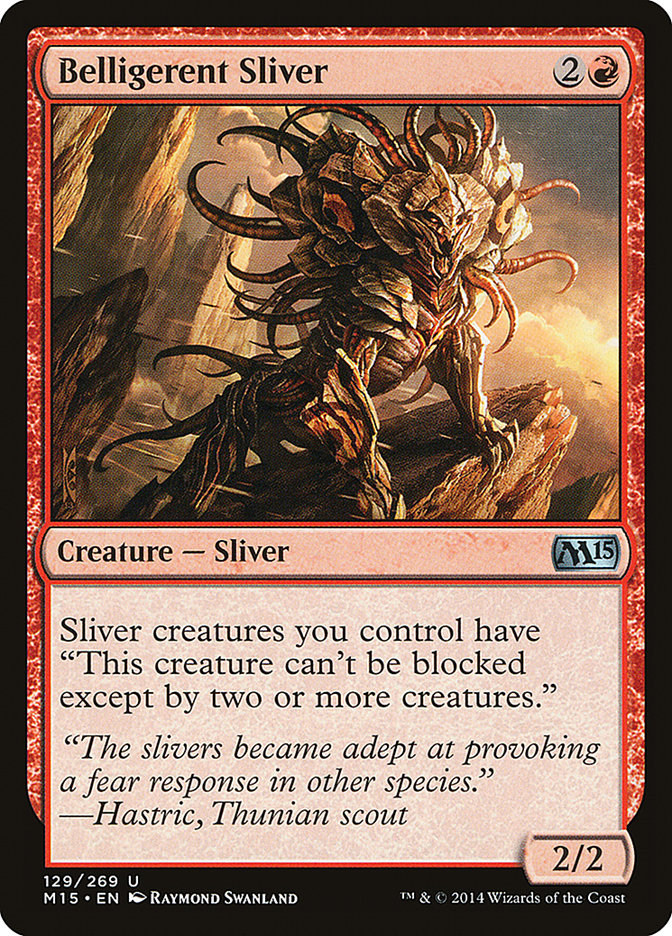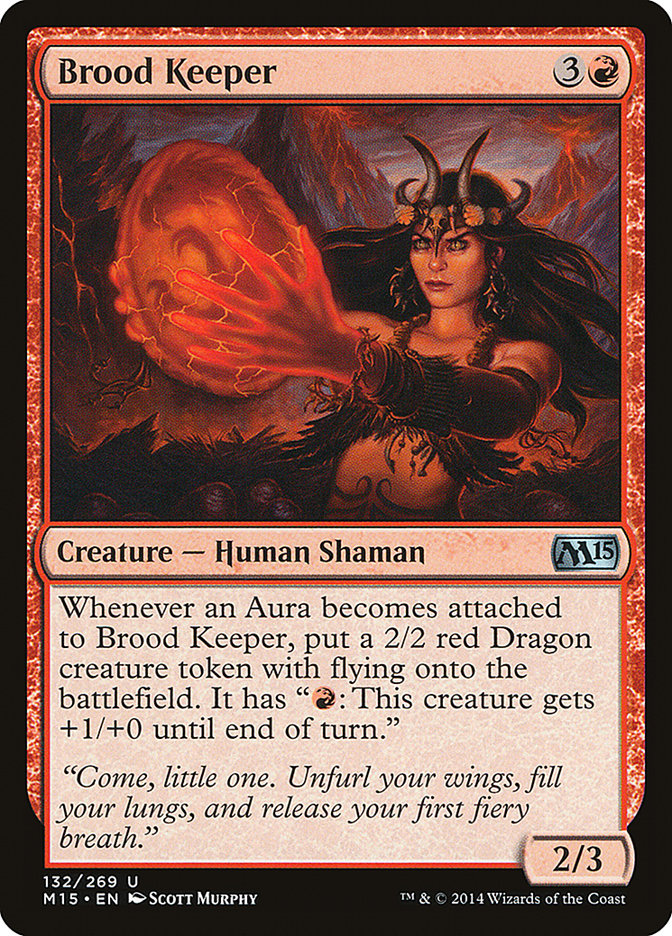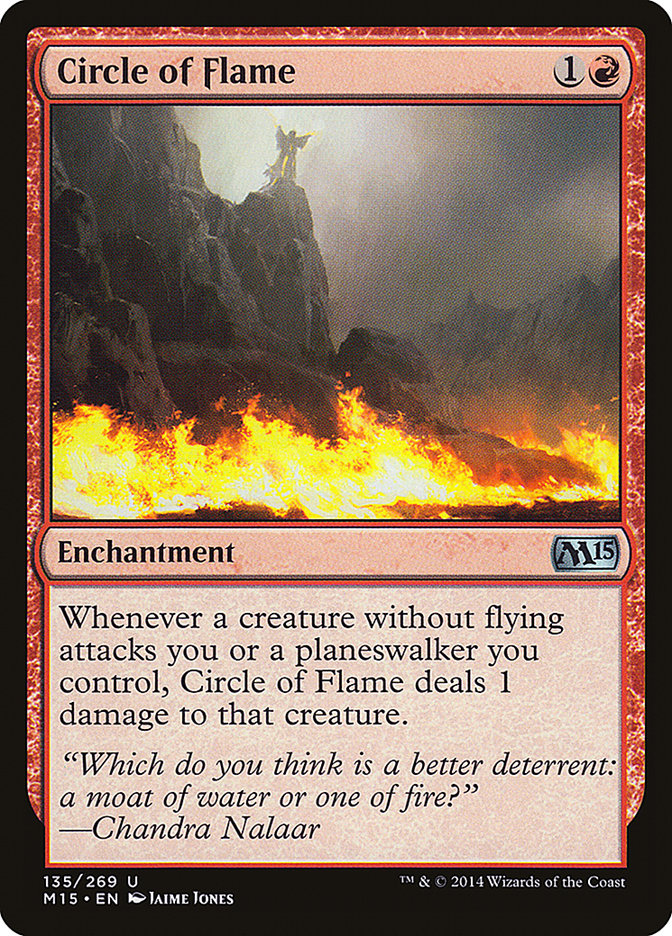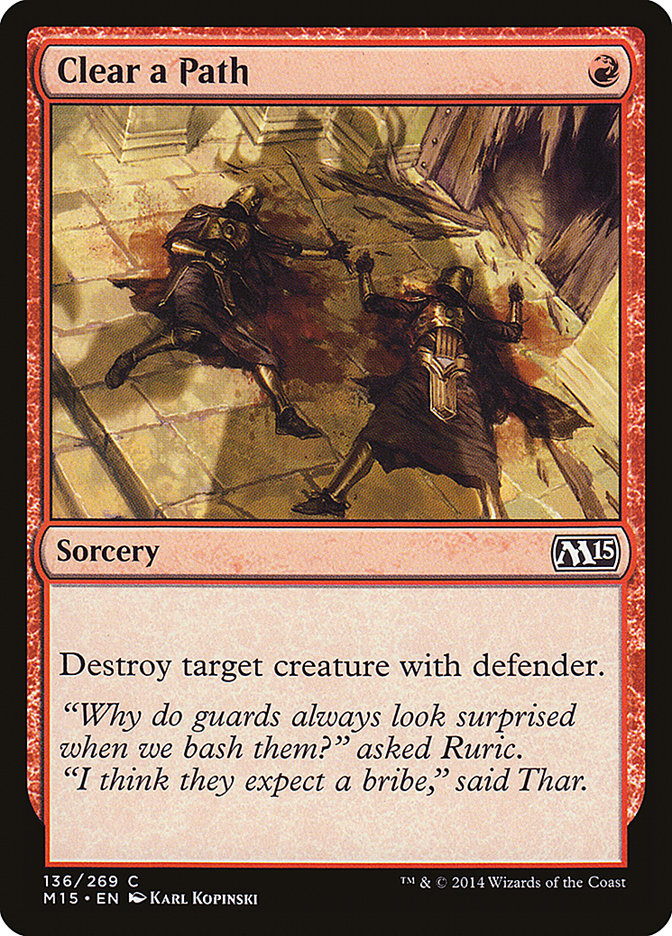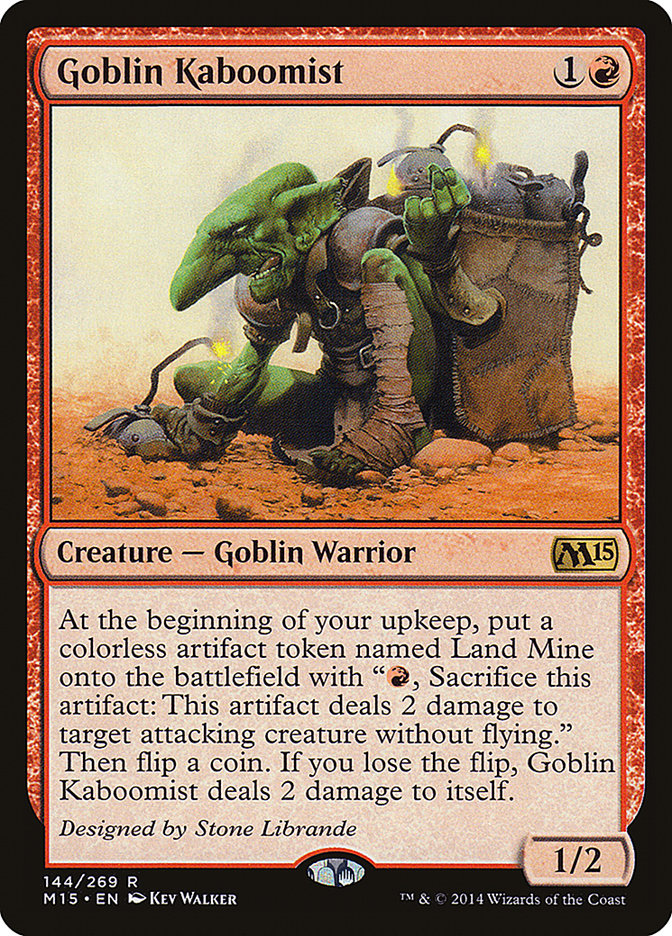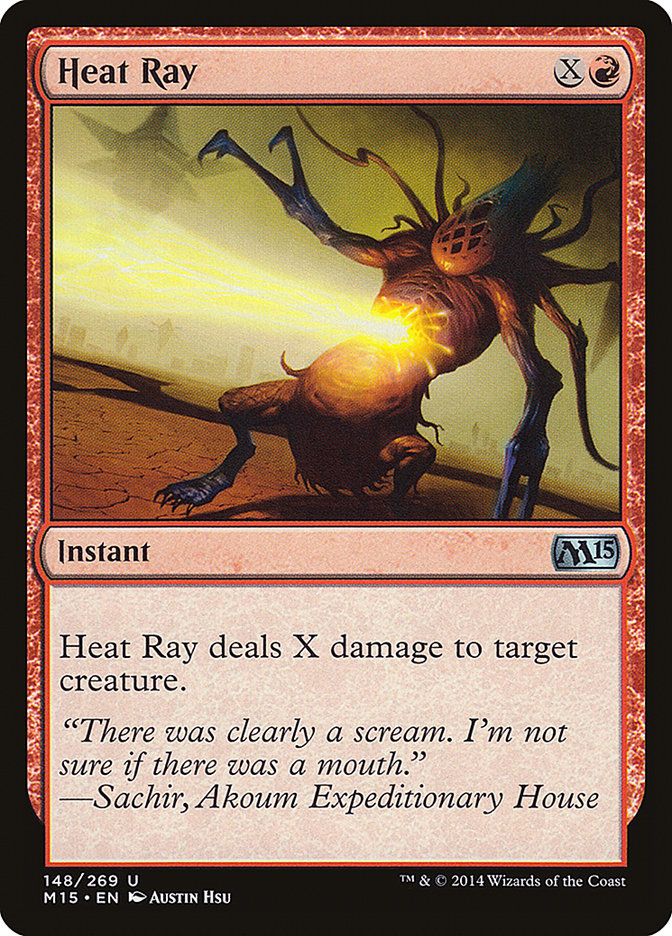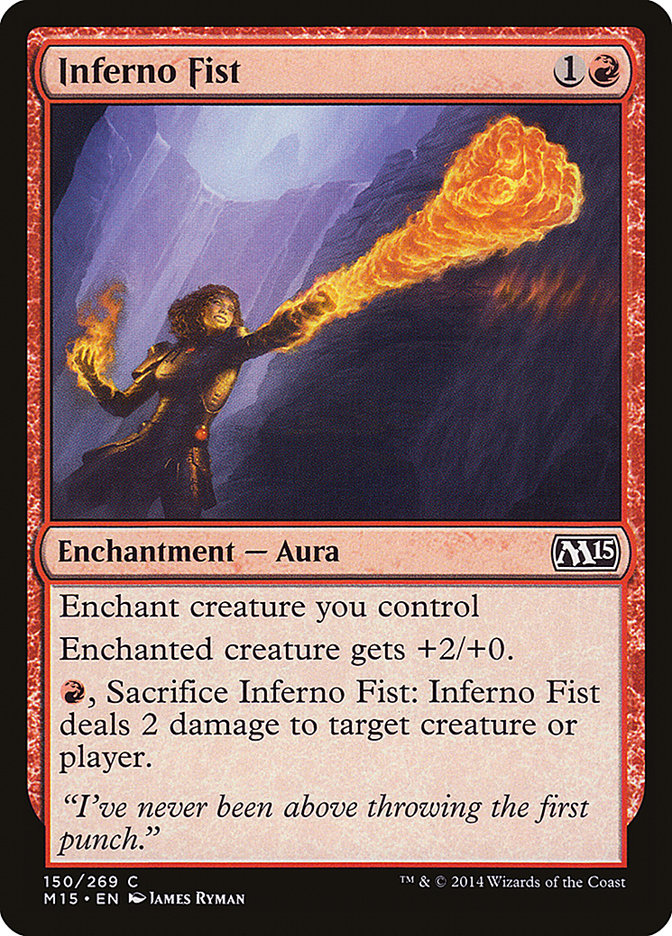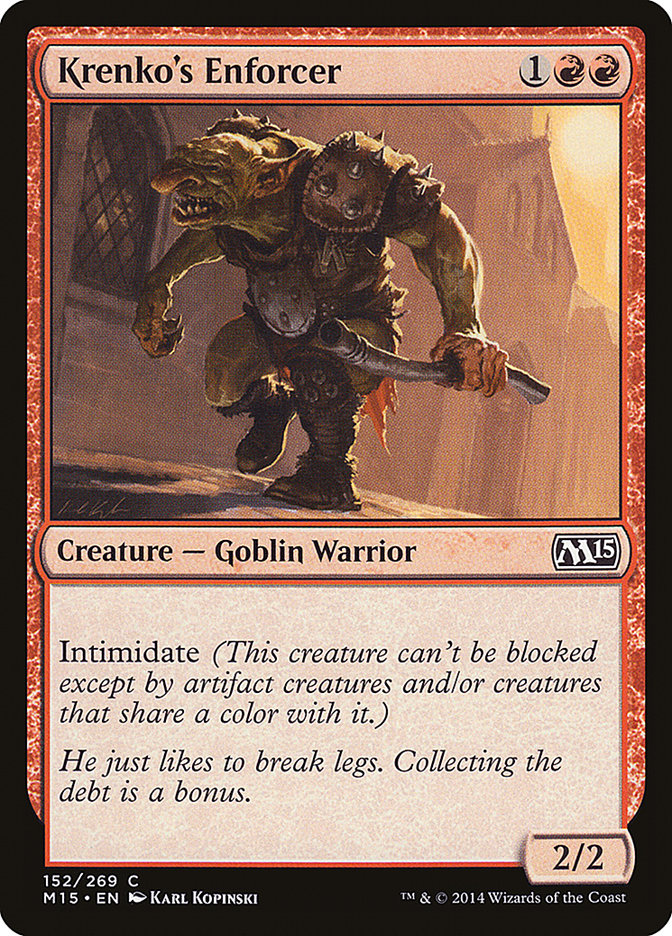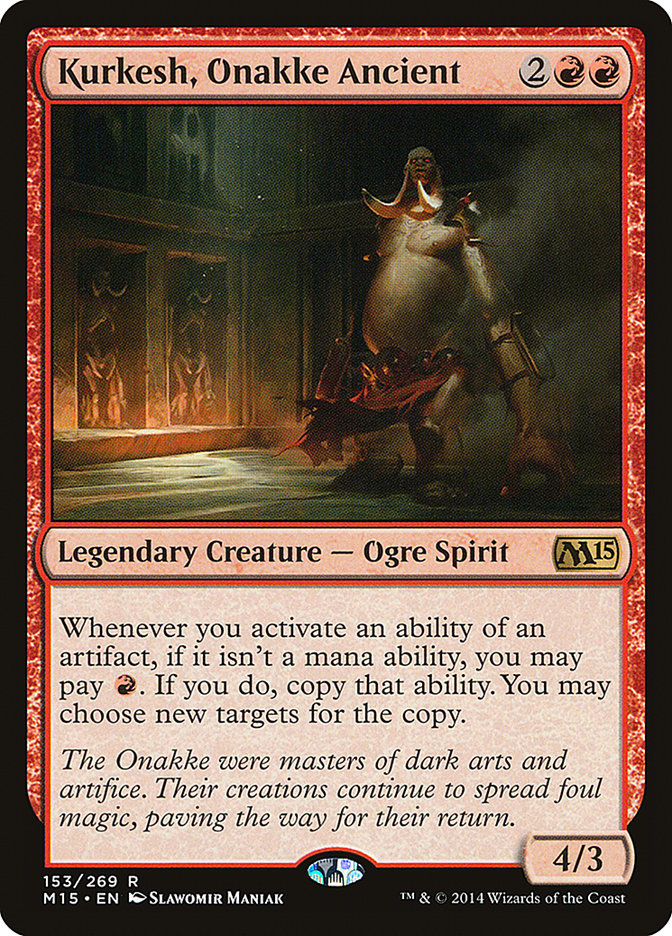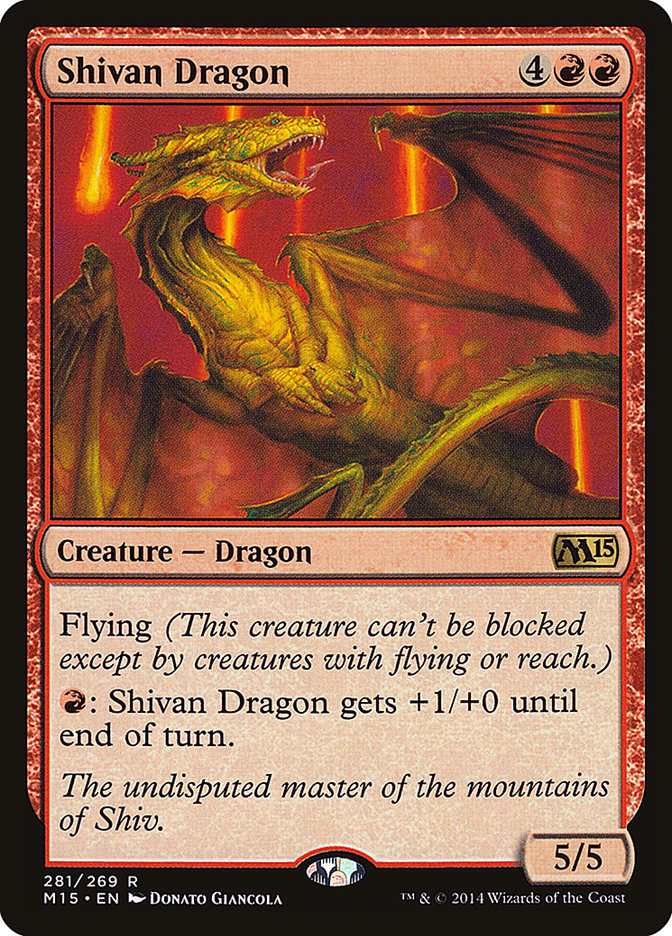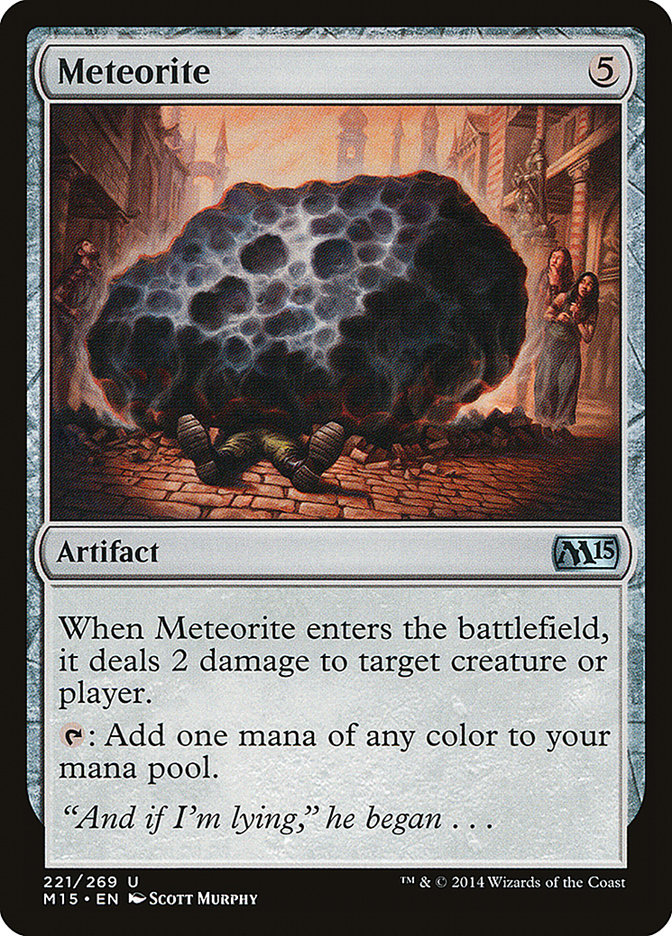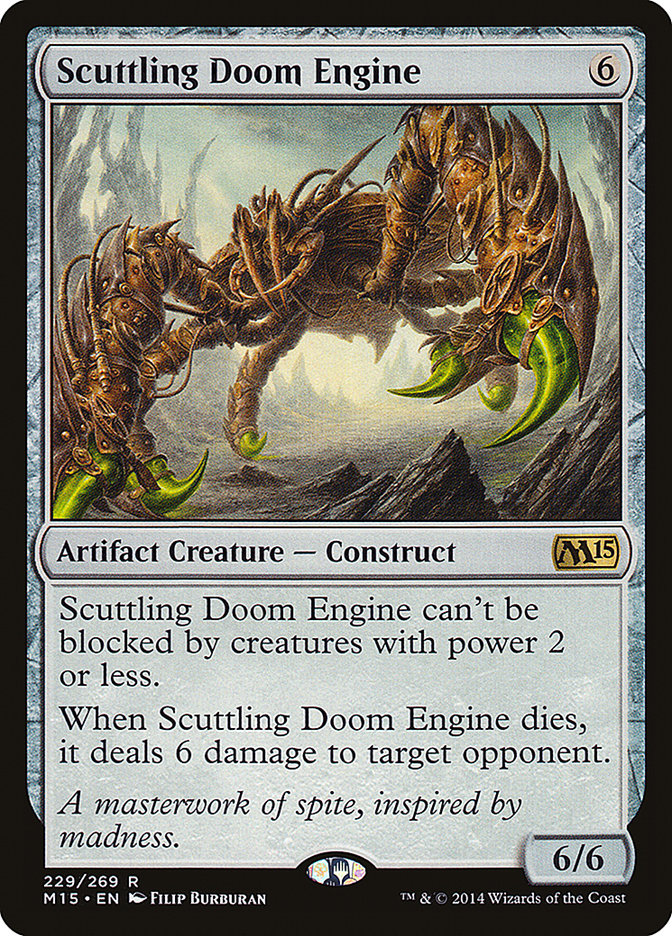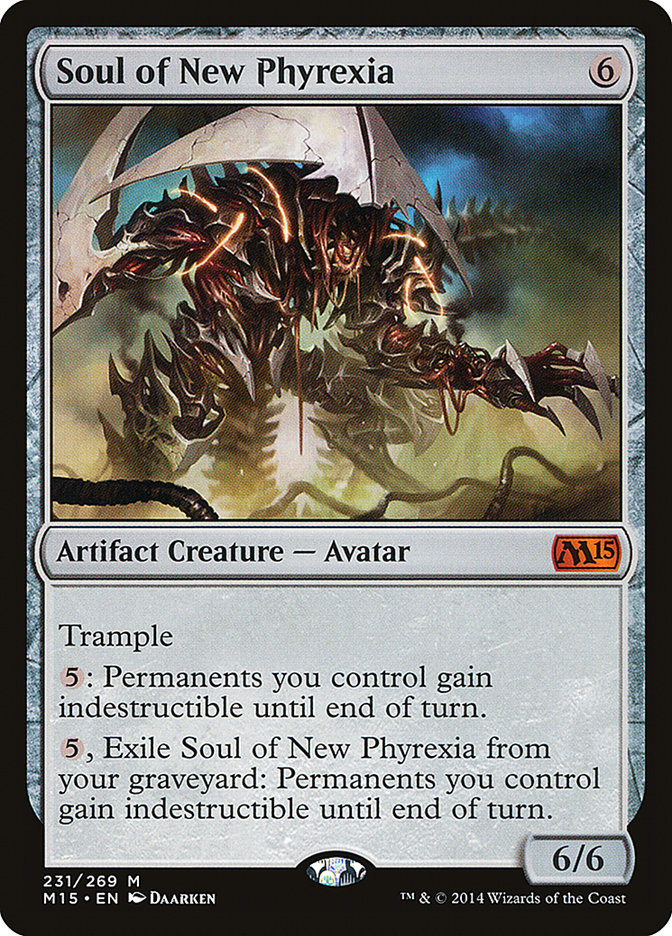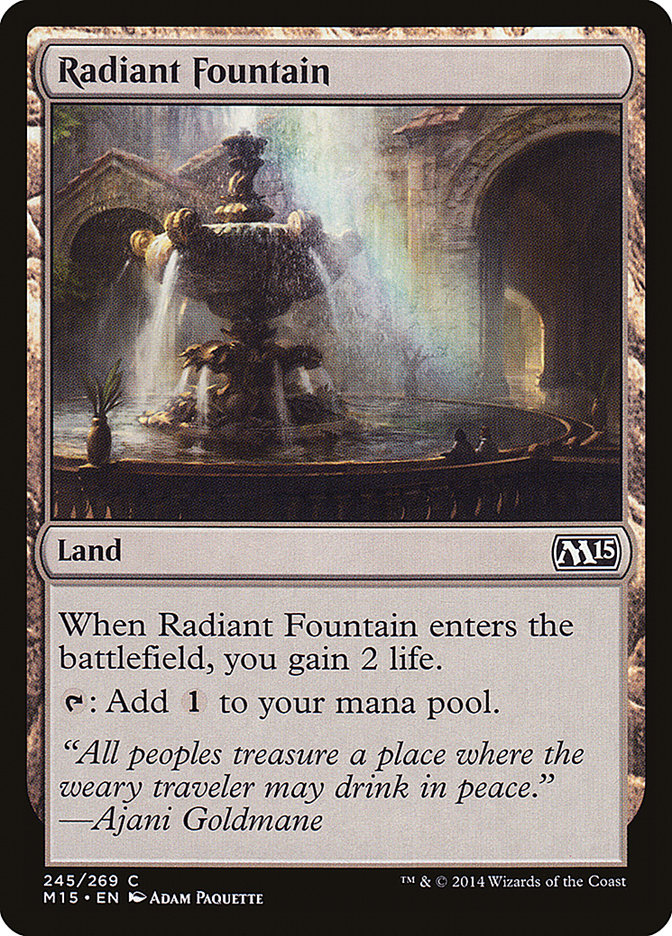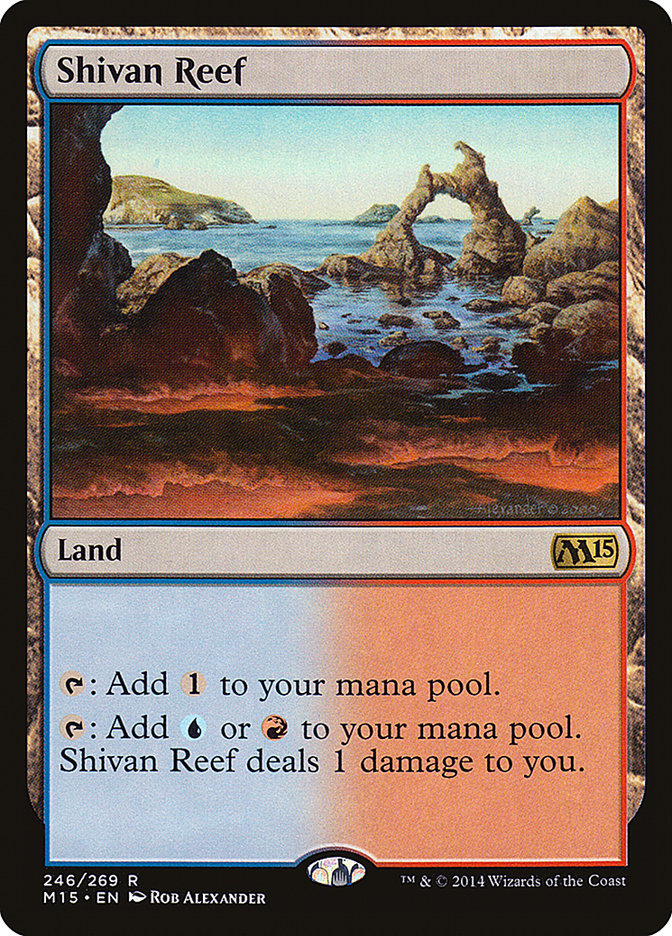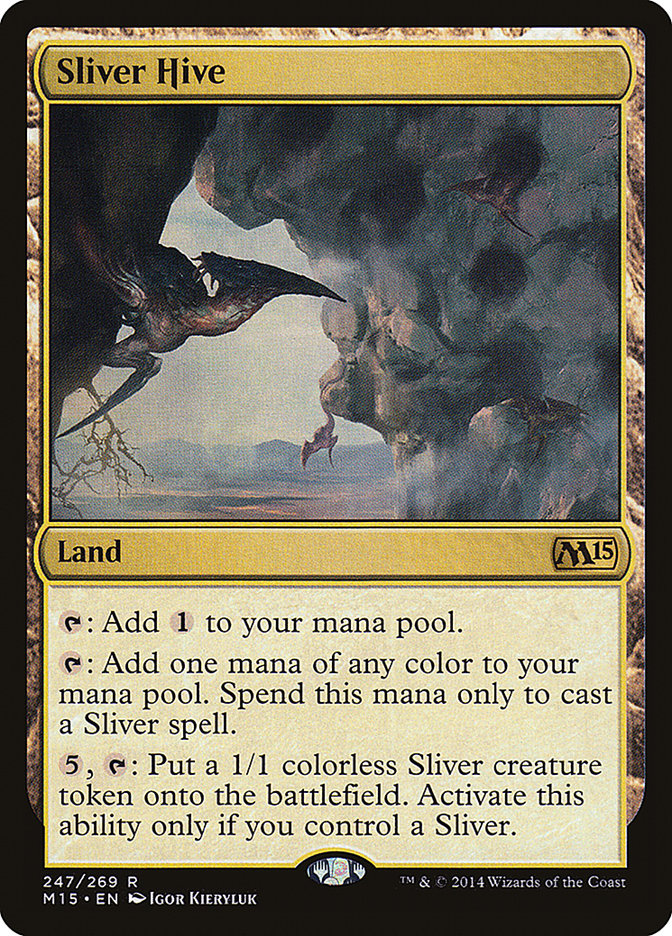Once again, like last year, this is not the Red Box review from Patrick Sullivan.
Patrick Sullivan is one of those people that I most look forward to seeing their opinion on red. I feel like, for example, even when we disagree about a card, Patrick is still looking at things from the correct perspective. That is, he looks at red cards from the perspective of “what is possible” and “what has worked”. So often I see red analysis that either fails to place cards in a context or ignores the new possibilities that a card might open up. I don’t know that I’ve ever seen Patrick make those mistakes.
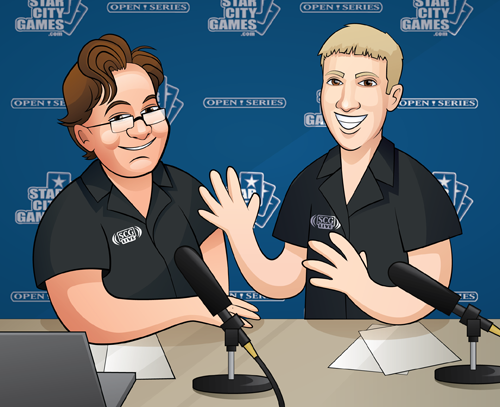
Lest you think that this is a PSully love-fest (and would that really be so bad?), I will say that there are times I disagree with him. That being said, even when I disagree with him, I definitely feel like he is being rational. At Pro Tour Hollywood in 2008, I think Patrick’s red deck (piloted by Andre Coimbra) and my red deck were the only internally consistent, rational red decks at the event. I’ve known Patrick for a very long time, but I feel like he’s only gotten better at this over time, perhaps as a result of his professional work as a game designer and developer.
Because I knew it was going to cover red, I took great interest in Patrick’s conversation with SCG editor Cedric Phillips this week. If you’re as interested in his opinions on red as I am, I think that it is a must-listen to hour. After all, there is a reason that ever since they let players consult outside notes between games, I have this at hand whenever I play red:
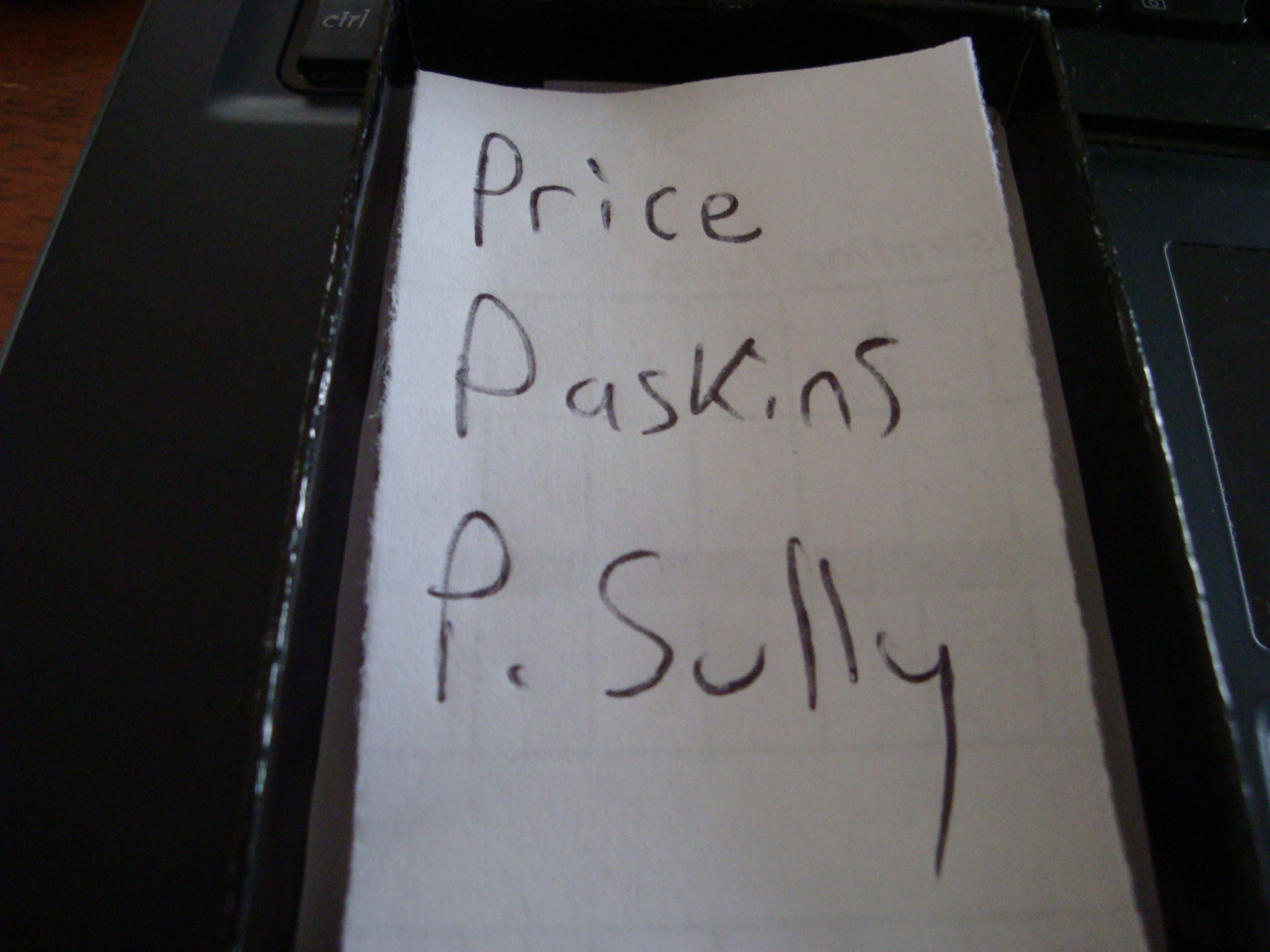
Revisiting Last Year’s Red Review
Last year’s M14 Red Review came about largely as a reaction to this card:
I complained to my longtime collaborator (and former Red God) Ronny Serio about the horrible positive opinions people had of this card. How someone could find room for this card in any deck blew my mind. How could it possibly compete with any of these:
Heck, even Pyrewild Shaman is a card that I’d expect to have a home in a deck in that era. I called this card “The Wildly Overrated” card from M14 reviews, and I’m glad how well that stood up.
Here are the cards I called “Excellent” for red:
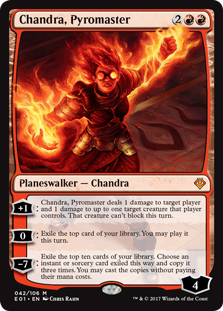
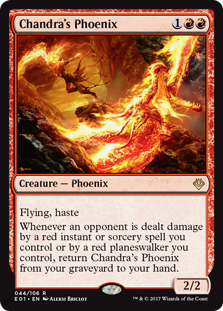
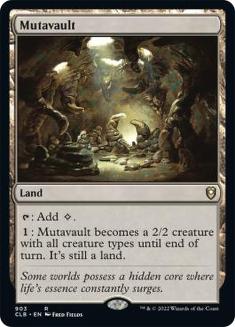
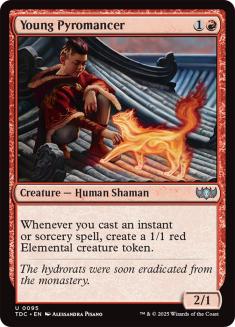

This held up remarkably well. I think it is particularly important to note that, at the time, people were greatly naysaying Chandra’s Phoenix, saying things like “I don’t know how playable it actually is”.
For the “good” cards, I named Shock, which seemed obvious, and two Goblins that didn’t end up doing much of anything, Goblin Diplomats and Goblin Shortcutter, though I think that wasn’t because they weren’t good enough, but rather that they didn’t have a home.
Overall, I look at my review, and I think I did a great job of identifying the best cards, the good cards, the sideboard cards, the marginal cards, and the unimportant cards. Generally speaking, most sets are designed with multiple formats in mind, limited among them, so some things are just not good enough for the constructed world. That’s just how it goes.
And so I am going to once again examine red, this time for M15. As last time, let’s start with a card that is in a category all by itself.
The Card to Watch
This is the kind of card that Wizards of the Coast tends to watch out for, careful to make sure that they don’t push the card too far. Effectively a zero-mana ability to draw two cards is the kind of thing that can go awry, whatever the alternate cost. I do fully expect that Wizards of the Coast R&D were very, very careful for this card not to go into the realm of “hot damn, that card is oppressive.
Minecraft guru Markus Persson is the person responsible for the design of this card, and I’m quite curious how close the printed version is to what he submitted. As it stands, this card can nearly immediately supply four cards in hand (two when cast, two on your opponent’s upkeep), and in any very-late-game situation, this could be absurd. Even a Sphinx’s Revelation-fueled high life total could easily fall to the kinds of cards we’re talking about here. The drawback is incredible real, but I certainly have visions of a kind of “Necropotence” style response to that drawback (neo-Nevinyrral’s Disk, perhaps?), and even if the drawback ends up being too much for Aggressive Mining to work, it may just be a single card away from being busted.
Watch this card.
The Excellent
As a 2/1 for two mana, Altac Bloodseeker is fine, but not great. That one toughness can matter, and you really need a special ability for it to go over the hump. Granting first strike, haste, and a pump ability is basically exactly the kind of thing that might do that.
Take, for example, something as simple as a turn 2 Altac Bloodseeker versus a turn 1 Elvish Mystic from Monsters into a turn 2 Courser of Kruphix. Here, an attack with Bloodseeker is actually a frightening prospect to either block or let through. It seems almost trivial for Bloodseeker to become a 4/1 first striker because of that Mystic. The potential in the card for two-for-one situations is huge. Even without that, the potential damage is really powerful.
Imagine a two-power one drop in that same example above. Attacking for two on turn 2, and following with an Altac Bloodseeker is good, but it doesn’t actually strain credulity to cast another Bloodseeker, on turn 3, and Shock the Elvish Mystic, swinging for eight first strike and having ten power on the board.
Whenever you can turn “remove your creature” into damage, this is a win-win for aggressive decks. Even more midrange red decks can gain a lot of value out of having access to a cheap threat that is bigger than expected.
All of the things I said last year still apply, though it has certainly become more clear since then just how unlikely the ultimate ability on Chandra, Pyromaster tends to be. In my own experience, once Chandra has cleared the board of targets, or isn’t supplying a clear path for attackers, the “0” is where this card has shined, and that will continue to be the case.
I, for one, am greatly excited that this card will still be legal for some time.
Here, we have a card that is rightly seeing the appropriate kind of love, largely because of history. I wonder if secretly this card was put into the set to try to add some buzz for a Mark Herberholz Hall of Fame bid, but there is no deny that Heezy is widely associated with this card because of its presence in his Pro Tour winning deck.
There is good reason for that. For many of the slower decks facing a swarm, laying a potent potential blocker can be a great plan. Frenzied Goblin, for all of its puny power, really puts a damper on that plan. Courser of Kruphix, Desecration Demon, Nightveil Specter, Polukranos, and Gray Merchant of Asphodel all just got a little bit worse because this card exists. Now all of those cards can continue to resist a red swarm style deck in other ways, but Frenzied Goblin makes their work just a little hard.
Even in the case where an opponent does successfully block or kill a Frenzied Goblin, this has generally meant that it has managed to do the damage already, or at least act as a lightning rod protecting a bigger cousin. If we add on a card like Hammerhand, we can get some surprisingly successful turns of attacking through the defense which could just take an opponent out. Tom Ross tried out Blinding Flare for a reason. Frenzied Goblin will end up playing a similar role.
Little needs be said about this Theros reprint. This card is an auto-include in Burn, and this type of card will always be a card that red players will consider in any strategy of red, even when it doesn’t necessarily make the cut.
This card is just really good.
Here is a moment where I slightly disagree with Patrick Sullivan about our assessment of a card. He called this card “a nug”, which is essentially to suggest that this is the kind of card that you’d play in a deck that is planning on directing the burn directly to the opponent. I actually think that this card is basically Flame Javelin. Yes, there will be times you pay four for Stoke the Flames, but there will be many times that you won’t, even without Young Pyromancer shenanigans.
Last year, I got fourth-place in Milwaukee and won a $5k with Red. I ended up with two Chandra’s Outrage in my sideboard by the time I won the $5k, and it had everything to do with wanting a card that I could reasonably bring in to deal four damage to both a creature and do something beyond that. The problem was that Warleader’s Helix simply couldn’t touch a Blood Baron of Vizkopa or a Stormbreath Dragon, so even though I had access to white mana, I wanted something else from the board. That card was, for a time, Chandra’s Outrage, and eventually became Fated Conflagration.
If Stoke the Flames had existed, none of those cards would have been bothered with. Not only does Stoke the Flames answer those creatures and more, but it can simply be directed to the opponent if need be, which is an incredible boon for aggressive red strategies.
Expect to see more of this card the more people play with it.
We already know that red/white decks are a presence in Standard. Battlefield Forge will do a great deal to make these decks even more powerful. Things like this have subtle effects, but they do make these decks more fundamentally powerful.
The Good
This card is going to get more important after the release of Khans of Tarkir, but this card is essentially a much-improved Rogue Kavu, a card that certainly was worthy of consideration in many aggressive decks.
This Gatecrash reprint will carry the legend of Foundry Street forward another year. We already know the card works in swarm decks, and this card will help that style of red stick around a little longer.
This card is a tricky one. Supplying a fresh 1/1 every turn (even that first turn) is a powerful ability, especially given that the 1/1s are hasty. You might be attacking for six power on turn 4 with just casting this spell, and that isn’t something to shrug at. However, the ‘must attack’ clause on Goblin Rabblemaster also means that you are very likely to see a lot of dead goblins coming in to no effect.
These two cards are going to be paired together for the next year. This is essentially because the cost of Shrapnel Blast demands a sufficient amount of artifacts, and Darksteel Citadel is nearly a free-roll. I’ve made this card work in the past (I got second in a PTQ in Extended with Shrapnel Blast, losing to Owen Turtenwald in the finals – his first PTQ win), but unless you are a specialized deck like Trading Post, wasting your time casting cards like Prophetic Prism isn’t going to get you there; expect successful Shrapnel Blast decks to spend their mana on cards that do something, like…
We’ve seen this card be very successful in Death and Taxes in Legacy. While that is a very different format, it does speak to the power of the card. Expect this to see play in decks that discover that they need an answer to a card that is nearly otherwise unanswerable, but they don’t want to lose the chance at damage.
The Sideboard Cards
If artifacts end up being a thing, Torch Fiend will be a very solid board card.
If the graveyard ends up being a problem needing an answer, Tormod’s Crypt will be that answer.
The Role Players
Forge Devil is a great card if there are a lot of x/1s in the format. Should that happen, expect this “FTK” to be common.
Generator Servant is an awesome Seething Song if you end up needing that kind of thing. Right now, the five-drop of choice isn’t in need of haste, but if Khans of Tarkir brings us something new, it might be an awesome card. Turn 4 Soul of Shandalar (below) doesn’t sound awful, either.
Seemingly taylor-made for Boss Sligh, this card will certainly see play in that deck, but I don’t expect it to translate to other decks.
While it will be in competition with Stormbreath Dragon, this card could be playable in a Big Red Artifact deck, fetching up utility artifacts as backups if you need such an effect. This won’t be toolbox-style but would likely be just a way to get more redundancy of good artifacts, daring an opponent to let the dragon stick around for more turns.
This card is going to live in the shadow of Stormbreath Dragon for the entirety of its existence. That Theros rare is simply going to outclass Soul of Shandalar for most red decks that are hoping to get big. However, once you get your four Stormbreath out of the way, if you still want fat, here is where you’ll go.
Last year, I said, “In a bigger red deck, this could make an excellent finisher.” If that deck ends up existing, that is still the case.
This card is an incredible answer to problems if you have the time to activate it and the inclination to supply an answer.
The Marginal (not worth major consideration, but still might have a purpose)
Are slivers real? This card might let us see.
A very marginal choice in the board of something similar to Boss Sligh should it find a matchup where there is a grind, and a miracle where it achieves four-mana without the game being over.
In controlling red decks, this might be reasonable if weenies are a problem.
If walls become oppressive after Khans of Tarkir, this might make a board.
Unopposed, on average, you’ll end up with two Shocks on a stick. In a deck that wants to control the table, that could be good enough for the kind of deck looking to do that.
A possible sideboard choice for a Big Red deck that might need to answer a small creature and a big creature from the same deck; i.e., a very unlikely choice.
This is a hefty investment in time, requiring that you might keep the mana open. It could still be worth it for some decks.
In Time Spiral Block, Skirk Shaman very occasionally saw play; in the right metagame, this could happen again.
If some better activated artifact abilities show up, Kurkesh will become reasonable.
It has a lot of competition, but this can be a “go over the top” card for those looking for one. Likelihood this will happen? Very low.
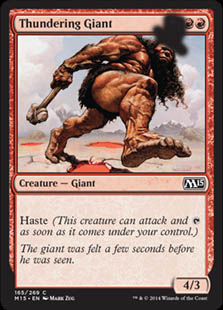
I once died to this card after Brainstorm-locking myself, my Yawgmoth’s Will stuck in hand, not enough mana to combo off. Ugh. It isn’t really marginal. The player who killed me was literally wearing a top hat. I just shudder whenever I see this Top Hat Giant.
Likely a card for Trading Post decks, it could end up making the cut in a Big Red style as well, though this is unlikely.
Another option for a Big Red deck, after Stormbreath Dragon has been put into the deck, as well as an option for Red Trading Post decks.
Again, another option for Big Red or Red Trading Post decks should they end up existing.
Big Red may end up wanting this if it is mono-colored and has enough other funky mana.
I have Battlefield Forge in the “excellent” section where I don’t have Shivan Reef, simply because there don’t appear to be the support cards in blue to really make a powerful red/blue deck that looks anything like we think of as a red deck. Perhaps there is a good blue deck out there that will use this, but this is the M15 Red Review, not the M15 Blue Review.
Another option for Big Red decks as long as Mutavault is still in print.
The Unimportant
As last year, I’m just reducing this to a simple list.
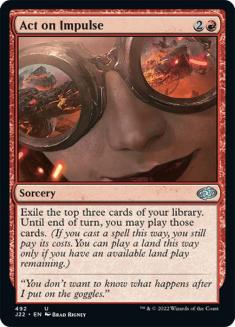
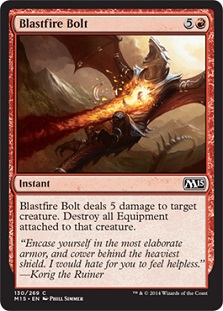
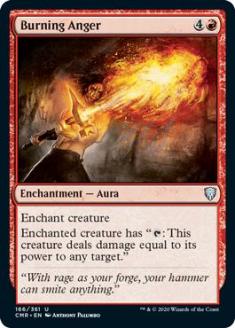
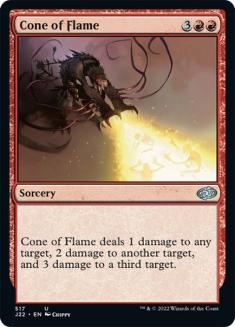
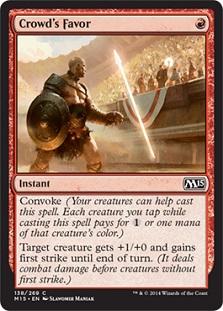
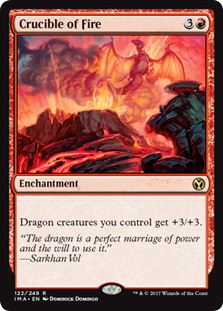
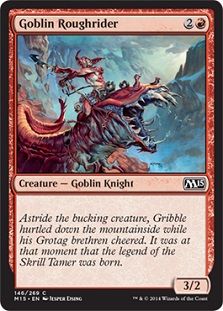
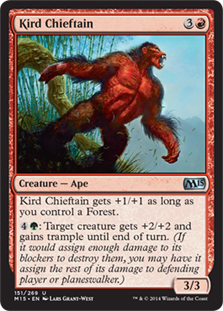
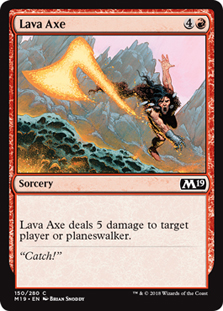
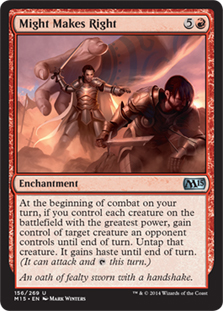
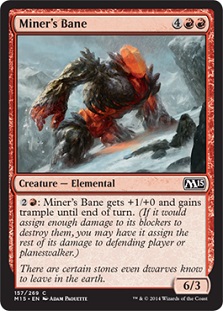
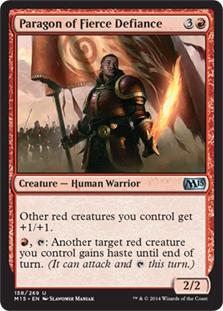
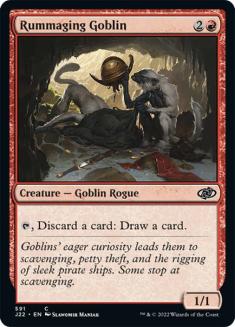
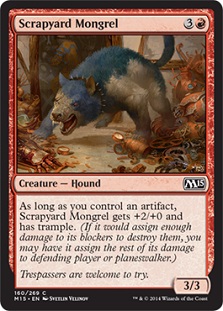
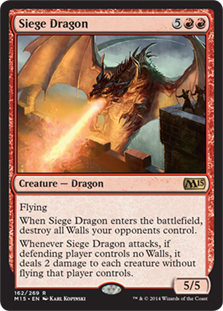
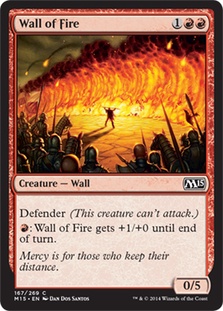

The Conclusion
I actually think that there are a lot of tools for a generally red deck, as well as specifically swarm style red decks (like Boss Sligh) and various Big Red or Trading Post Red decks. That last pair of archetypes haven’t existed in a long time, and it is fairly likely that there is not enough here for them to be able to even begin to exist. That being said, it is very worthwhile to recognize that the tools are there to work with, and if there are enough of them, you could potentially do something about it.
The big winners from M15 are traditional red aggro decks (“Sligh”) and the swarm lists like Boss Sligh, which gain some efficient creatures and access to Stoke the Flames, a card that I think is going to become omnipresent soon. Burn also gets some tools, so expect to see it continue to do well in Standard for the next few months.
As for me, I’m brewing up a storm for many of my friends who will be in Portland for Pro Tour M15. While I’m not qualified, you can expect that I’ll be carefully watching this weekend’s SCG Baltimore for any more insights, both for red in general, and for the Pro Tour. I know I’m curious if there is another “Quenchable Fire” that I missed – that perfect kind of marginal card that does a job that it needs to do.
Until then, I hope you are brewing red decks along with me.

